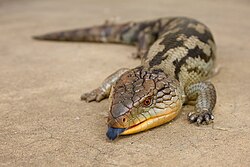Blue-tongued skink
Genus of lizards From Wikipedia, the free encyclopedia
Blue-tongued skinks[2] comprise the Australasian genus Tiliqua, which contains some of the largest members of the skink family (Scincidae). They are commonly called blue-tongued lizards or simply blue-tongues or blueys in Australia or panana in Indonesia. As suggested by these common names, a prominent characteristic of the genus is a large blue tongue that can be bared as bluff-warning to potential enemies.[3] Their tongue can also deform itself and produce a thick mucus in order to catch prey.[4] They are relatively shy in comparison with other lizards, and also significantly slower due to their shorter legs.
Systematics and distribution
Blue-tongued skinks are closely related to the genera Cyclodomorphus and Hemisphaeriodon. All species are found on mainland Australia with the exception of Tiliqua gigas, which occurs in New Guinea and various islands of Indonesia. The Tanimbar blue-tongued skink, a subspecies of Tiliqua scincoides, is also found on several small Indonesian islands between Australia and New Guinea. Tiliqua nigrolutea, the blotched blue-tongued skink, is the only species present in Tasmania.
Ecology
Most species are diurnal, ground-foraging omnivores, feeding on a wide variety of insects, gastropods, flowers, fruits, and berries.[5] The pygmy blue-tongue is again the exception, being primarily an ambush predator of terrestrial arthropods.[6]
All are ovoviviparous, with litter sizes ranging from 1-4 in the pygmy blue-tongue and shingleback to 5-24 in the eastern and northern blue-tongues.[7]
Species
Summarize
Perspective
| Name | Scientific Name | Picture | Subspecies |
|---|---|---|---|
| Adelaide pygmy blue-tongue skink | T. adelaidensis (Peters, 1863) |  |
|
| No common name | †T. frangens[8] |  |
|
| Indonesian blue-tongued skink | T. gigas (Schneider, 1801) |  |
T. g. gigas, Giant blue-tongued skink; T. g. evanescens, Merauke blue-tongued skink; T. g. keyensis, Key Island blue-tongued skink |
| Centralian blue-tongued skink | T. multifasciata (Sternfeld, 1919) |  |
|
| Blotched blue-tongued skink | T. nigrolutea (Quoy & Gaimard, 1824) |  |
|
| Western blue-tongued skink | T. occipitalis (Peters, 1863) |  |
|
| Shingleback, bobtail | T. rugosa
(Gray, 1825) |
 |
T. r. aspera, Eastern shingleback; T. r. konowi, Rottnest Island bobtail; T. r. palarra, Shark Bay bobtail; T. r. rugosa, Common shingleback, bobtail |
| Common blue-tongued skink | T. scincoides (White, 1790) |  |
T. s. chimaerea, Tanimbar blue-tongued skink; T. s. intermedia, Northern blue-tongued skink; T. s. scincoides, Eastern blue-tongued skink |
| Irian Jaya blue-tongued skink | Tiliqua sp. |  |
|
Extinct species
Multiple extinct species have been proposed. T. frangens, the largest known species of the genus, lived during the Pliocene and Pleistocene epoch around the Wellington Caves of New South Wales in Australia. Another extinct species T. laticephala may represent the same taxon as T. frangens. Its nearest relative is the extant T. rugosa, which is half the size and lacks the bony plates of T. frangens.[9][10][11]
Another extinct species T. wilkinsonorum also lived during the Pliocene epoch. The earliest possible species is T. pusilla from the middle Miocene, but researchers question whether this species belong to the genus Tiliqua due to its uncertain phylogenetic position that causes paraphyly.[9]
In captivity
Some species of this genus are kept as household pets. They are on average very friendly when raised in captivity, and are often called 'the dogs of reptiles'. Captive specimens can live 20 years or longer.[12]
Notes
References
External links
Wikiwand - on
Seamless Wikipedia browsing. On steroids.

